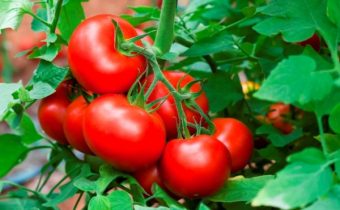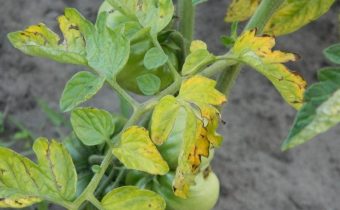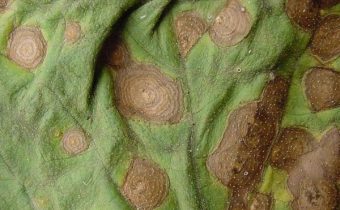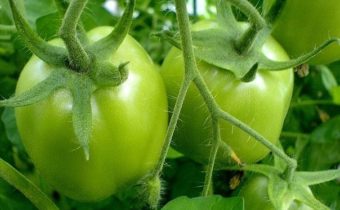Gray rot on tomatoes in the greenhouse, what to do? (Kagatnaya rot)
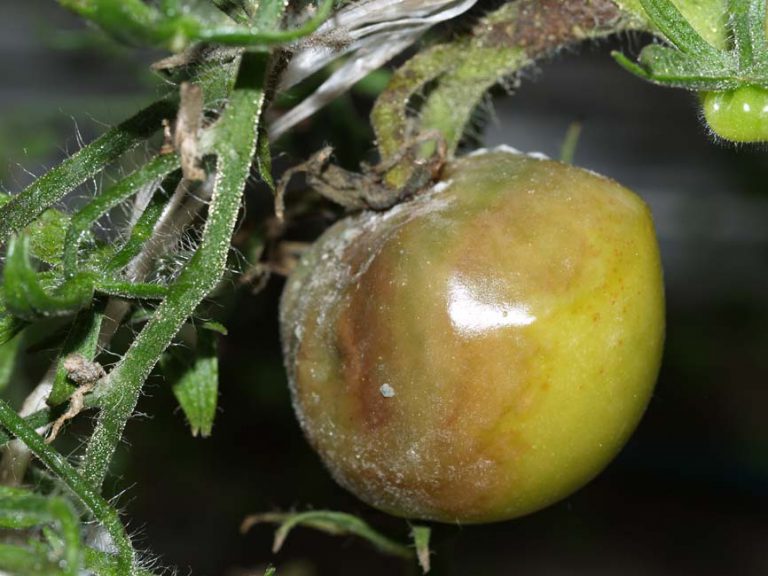
When growing tomatoes in greenhouses, gardeners are confronted with infection that is dangerous for the crop - gray rot. If no protective measures are taken, the disease instantly spreads over the plantings, which leads to significant crop losses.
- Biology of gray mold pathogen
- Causes of the disease
- Symptoms of gray mold
- Effective agrotechnical techniques in the fight against gray mold
- The use of biological agents in the fight against gray mold
- Chemical agents to combat gray mold
- Folk remedies
- Approximate scheme of preventive measures against gray rot
Biology of gray mold pathogen
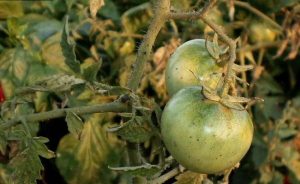 The disease is caused by a fungus of the species Botrytis cinerea Pers, belonging to the biological group of saprophytes. It develops in the presence of air (aerobic), temperature indicators from + 3 ° C to + 42 ° C at a humidity of 100%. It forms mycelium (mycelium), conidia, and also under adverse conditions - sclerotia. Sclerotia retain the ability to germinate even after 2-3 years.
The disease is caused by a fungus of the species Botrytis cinerea Pers, belonging to the biological group of saprophytes. It develops in the presence of air (aerobic), temperature indicators from + 3 ° C to + 42 ° C at a humidity of 100%. It forms mycelium (mycelium), conidia, and also under adverse conditions - sclerotia. Sclerotia retain the ability to germinate even after 2-3 years.
The fungus is preserved on plant debris, seeds, roots, spreads by air, as well as with water droplets when caring for plants. The infection infects a wide variety of plants (up to 200 species, including ornamental crops), while the rate of spread of the fungus is very high.
The second name of gray rot is kagatnaya, from the word “kagat” - a heap. The fact of the matter is that often the fungus infects already gathered and piled up vegetables and fruits, turning the crop into a clump of gray moldy mass.
Causes of the disease
Gray rot causes serious damage to the tomatoes in the greenhouse. The factors that can cause infections are as follows:
- Wrong temperature conditions. High humidity and heat are the best conditions for pathogen development. A fungus appears in cool, wet weather, quickly hitting tomato bushes.
- Excessive watering of tomatoes.
- Excess nitrogen fertilizer in the soil.
- Pests on tomatoes: aphid, thrips. Weakened and damaged by pests plants are affected by the fungus more often.
- Thickened planting tomatoes.
- Lack of greenhouse disinfection after harvest.
- Use for planting infected seeds.
- Failure of crop rotation on the site.
The fungus remains on plant residues after harvesting, in the soil, and if you do not carry out proper prophylaxis (disinfection of soil, shelters, implements), do not remove the tops in time, leaves from garden crops, the risk of a dangerous infection appears on the site.
In addition to tomatoes, kagatnaya rot affects strawberries, potatoes, beets, radishes, cucumbers, onions.
Tomatoes pick up the infection from infected crops, and the plants also get sick when they are planted in the beds, where cucumbers or lettuce infected with fungus had previously grown.
Symptoms of gray mold
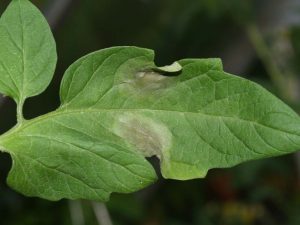 The first sign of plant damage by the dangerous fungus Botrytis cinerea Pers is the appearance of grayish spots, similar to ash dust. At first (5-6 days) there are no spores on the spots, the spots increase in size. Most often they appear near the places where the leaves and shoots are cut off.
The first sign of plant damage by the dangerous fungus Botrytis cinerea Pers is the appearance of grayish spots, similar to ash dust. At first (5-6 days) there are no spores on the spots, the spots increase in size. Most often they appear near the places where the leaves and shoots are cut off.
A week later, the spots lighten, the stalk is surrounded by light brown stripes. Inside the stem in this place is the dying off of blood vessels, so the leaves above them turn yellow and dry. Later, after about 10–12 days, a gray patina is observed on the spots (they become terry), which indicates the appearance of the pathogen conidia.Then the infected areas soften and die.
The infection passes from the shoots to flowers, fruits, gradually affecting the whole plant. The disease spreads throughout the greenhouse and without timely protection and action, most of the tomato bushes die.
Effective agrotechnical techniques in the fight against gray mold
Do gardeners have a lot of experience in dealing with a dangerous infection, but experts say that any disease is easier to prevent than to engage in treatment. Therefore, first of all it is important to comply with the agrotechnical of tomatoes.
- Tomatoes like abundant rare irrigation, but do not tolerate high humidity. Therefore, after irrigation, it is necessary to ventilate the greenhouse, opening the vents and doors.
- Loosening the soil after irrigation is another indispensable condition for growing tomatoes. If there is no time for this, it is useful to mulch the soil with hay, peat, humus.
- Tomato is a crop that needs plant formation. Masking and leaf removal are mandatory agrotechnical techniques for most varieties and hybrids. The wounds formed during cuts are a focus for infection, so all operations are carried out carefully, in the morning, using disinfected sharp knives or scissors. During the day, in dry weather, the wounds are tightened and dangerous pathogens will not fall into them.
- All cut leaves, shoots of tomatoes removed from the greenhouse. On ridges should not be weeds, plant debris.
- Water the bushes of tomatoes under the root, preferably in special grooves or holes.
Do not let moisture on the leaves, flowers and fruits of plants.
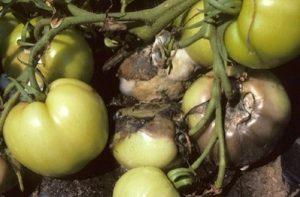
- When feeding, you also can not allow contact with plants compounds with fertilizers. This causes burns, various defects on the leaves and shoots, which leads to a weakening of the tomatoes and increases the risk of Botrytis cinerea Pers.
- Each year, change the place for planting with tomatoes, returning them to their original place no earlier than in 3-4 years. If this is not possible, in the fall they disinfect the greenhouse, remove the top layer of soil on the ridges and replace it with a new one. In the spring, it is recommended to plant siderats in front of the tomatoes, to spill the soil with a solution of potassium permanganate (to disinfect the soil).
- A good effect for healing the soil is given by planting taggetes (marigolds), calendula (marigolds), mustard. These plants secrete special substances that have a detrimental effect on the spores of the fungus of the gray mold.
- When planting, use only healthy seed. When collecting their seeds, it is mandatory to disinfect the potassium permanganate solution before sowing seedlings. When planting seedlings comply with the recommendations on the scheme of distances between plants. Not allowed dense planting of indeterminate tomatoes in the greenhouse. This leads not only to a lack of nutrients, but also to the appearance of numerous diseases.
- For irrigation it is recommended to install in the greenhouses the drip irrigation system.
- Tomatoes that are completely resistant to infection are not bred. But hybrids Pilgrim F1 and Vasilievna F1 have proven to be resistant plants, to a lesser extent compared to other tomatoes, affected by a dangerous fungus.
The use of biological agents in the fight against gray mold
In order to contain and prevent the appearance of secondary foci of the disease, means are used on tomatoes:
- Trichodermin;
- Glyocladin.
The methods are labor intensive, but the use of drugs gives a long lasting effect.
Trichodermin
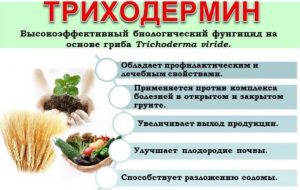 The preparation is based on bioactive substances secreted by beneficial soil fungi Trichoderma sp. Trichodermin is used against a number of fungal diseases, including gray rot.
The preparation is based on bioactive substances secreted by beneficial soil fungi Trichoderma sp. Trichodermin is used against a number of fungal diseases, including gray rot.
Available in the form of an aqueous suspension, dry powder. It is necessary to use the agent at a temperature above + 14 ° C, since with such indicators spore activity is manifested.
Application
- Suspension Trichodermin lubricate the affected places on the plant.
- After cuts of stepsons or leaves, it is recommended to lubricate the wounds with a suspension of the drug for the purpose of prevention.
- Spraying tomatoes with water suspension.
For spraying prepare the composition: 100 ml of the drug is diluted in a bucket of water.
Chlorinated water is not suitable for the preparation of the composition, since chlorine kills the beneficial spores of the fungus.
Tomatoes are processed in the morning so that the plants have time to dry before night.
Glyocladin
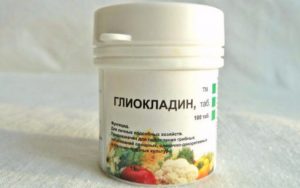 The drug is based on the fungus Trichoderma harzianum VIZR-18, which penetrates into the colonies and sclerotia of pathogens and destroys them.
The drug is based on the fungus Trichoderma harzianum VIZR-18, which penetrates into the colonies and sclerotia of pathogens and destroys them.
The drug does not accumulate in the soil, plant tissues, it is safe for people, animals. To treat tomatoes, a powder is used that is diluted in water (50 grams of product per liter).
Both drugs are effective in the early stages of manifestation of gray rot, but if the disease has spread to many plants, it is necessary to promptly apply chemical agents.
Gardeners practice processing plants with sodium humate (growth regulator), which prevents the appearance of a dangerous fungus on tomatoes.
Chemical agents to combat gray mold
Fungicides are used to coat plants damaged by fungus gray rot, and continuous spraying is used only for massive lesions of tomatoes.
With a small infection, it is permissible to use the compositions
- Ditan M-45;
- Bordeaux mixture;
- Profit;
- Integral;
- Soon;
- Fundazol.
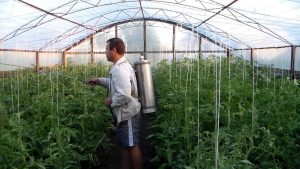 A good effect gives the processing of tomatoes with drugs Hom, Oksihom, Abiga-Peak.
A good effect gives the processing of tomatoes with drugs Hom, Oksihom, Abiga-Peak.
For the destruction of pathogenic fungi apply the drug Euparin. It is a contact fungicide, available in powder form. The drug is based on dichlorfuanide, which has a detrimental effect on fungal sporulation.
The drug is diluted in water (2% solution is used on tomatoes), observing the dosage according to the instructions.
Of the system-contact means on tomatoes shows the use of Ordan, Previkur, Acrobat MC.
For coating the plants affected by gray rot (stems, leaves), a special paste mixture is used.
Pasta Recipe:
- 300 grams of CMC glue;
- 30 grams of any fungicide;
- a bucket of water.
The glue and fungicide are stirred in water until completely dissolved, then chalk is added to make a paste. Put the mixture on the spots, while grabbing and healthy tissue around the site of injury. After 10-12 days obmazyvanie repeat.
Folk remedies
To combat the infection used folk remedies, among which the most effective:
- soap solution (spraying tomatoes with green garden soap solution);
- boric acid (treatment of plants with 1% solution of the product);
- baking soda (80 grams of soda are taken to a bucket of water, carefully dissolve and treat the affected bushes).
Such formulations help to cure tomatoes only if the infection is noticed at an early stage and there is not much damage.
Approximate scheme of preventive measures against gray rot
In order to minimize the risk of the appearance and effects of gray mold damage, the processing of tomatoes and shelters where they grow, must be timely.
Approximate treatment plan:
- in the spring - tillage with special preparations Fitosporin, Gliokladin;
- the beginning of summer - a plastering of tomato bushes in the presence of disease foci on them;
- August - treatment of plants with fungicides (if gray mold manifested itself massively on plantings);
- September - re-treatment of plantings.
After harvesting the fruit, it is required to conduct a disinsection of greenhouses, process the soil, and replace it.
Gray rot, which is dangerous for tomatoes, can be prevented by preventive measures and adherence to agricultural practices. In the case of infection of plants with an infection, special preparations are used, strictly following the dosages.


